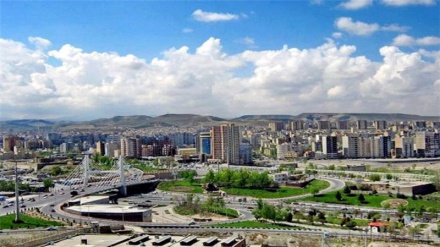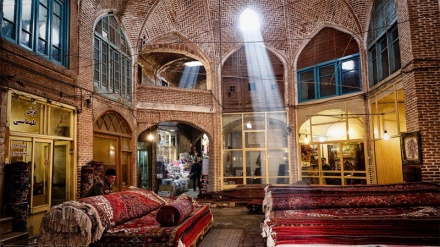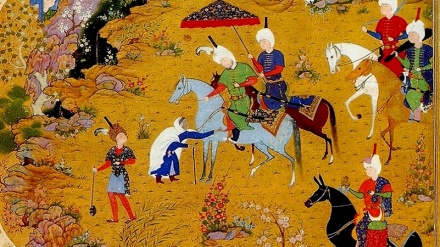Tabriz, 2018 (2)
Welcome to this week's edition of the series Tabriz, 2018. The city of Tabriz has been chosen as the exemplary touristic destination in the World of Islam in the year 2018. This city managed to introduce itself as the most modern, healthiest, most beautiful and developed city of Iran. Today, we pay a glance at the geographical location and history of this city.
Tabriz is a large city in northwest Iran, and the capital of East Azarbaijan Province. This city bounds to mountainous regions from the north, south, and east, and to plains from the west. It is located at a 599-kilometer distance from Tehran.
Two rivers run through Tabriz and its surroundings. Talkh-e Roud is a permanent river which runs through northwest of the city of Tabriz, while the seasonal river of Qoreh Chai runs through central part of this city, ultimately pouring into Talkh-e Roud River, in the northwestern corner of this city.
This city maintains warm and dry summers, and chilly winters. Winter season is chilly in this city due to its high altitude and the mountainous nature of this region.
The early history of the city of Tabriz is shrouded in obscurity. The earliest existing writing about Tabriz, is an inscription which is attributed to the Assyrian King, Sargon II. Also recent discoveries in the vicinity of central Tabriz, are indicative of the existence of an ancient civilization in the current location of this city throughout the First and Second Millennia BC. Throughout the course of history, Tabriz has been chosen as the capital city of a number of kings. The present day city of Tabriz has been built on the ruins of one of the main previous regional trade hubs, and was of paramount importance due to bridging the East and the West. This city was the capital of region during the reign of the originally Parthian rulers of Armenia.
This city expanded further, and gained more importance in the post-Islamic era, and as of the first half of 3rd Century AH. The Abbasid Caliph, Motavakel, in the aftermath of a destructive earthquake which rocked this city and reduced it into ruins, in the year 858 AD, instructed the immediate reconstruction of this city. This city which was growing and developing during the rule of Abu Mansour, suffered major damages in the wake of a quake which jolted this city in the year 1043 AD. When the renowned Iranian poet and traveler, Naser Khosrow, visited this city in the year 1037 AD, the area covered by this city was seemingly one square kilometer.
Upon the death of Ghaznavid King, Sultan Mahmoud, in the year 1131 AD, tensions ran high between Sultan Mahmoud's son, Davoud, and his brother, Masoud, for the possession of the city of Tabriz, with Davoud emerging victorious and naming the city as his ruling's capital. Based on historical evidences, as of 14th Century AD afterwards, Tabriz became the permanent capital of Azarbaijan. In the early years of 7th Century AH, Mongols raided this city twice. However, Mongol troops withdrew from Tabriz, after receiving compensation. In the year 1230 AD, Mongols ultimately occupied the city of Tabriz, and the Azarbaijan region.
Throughout the rule of Ilkhanid Dynasty, the city of Tabriz reached its peak of prosperity. The second ruler of this dynasty chose Tabriz as the capital of his ruling system, governing a region, which stretched from River Nile to Central Asia.
The Venetian Traveler, Marco Polo, who passed through the city of Tabriz in the year 1275 AD, pointed out: "Tabriz is a very large city, which is surrounded by beautiful orchards. The geographical location of this city is excellent. Goods are imported to this city from all regions."
The glorious era of Tabriz continued during the Timurid Dynasty and early years of Safavid Iran. In the year 1500 AD, Safavid King, Shah Ismail, seized the city of Tabriz, establishing the first capital city of the Safavid era in this city. The vicinity of this city to Iran-Ottoman Empire border, made this city vulnerable to threats, such that this city was occupied by the Ottoman troops a number of times, until the year 1514 AD, in which the Safavid King, Shah Tahmasb, transferred the capital city of this dynasty, from Tabriz to Qazvin.
Upon the empowerment of Qajarid Dynasty; the city of Tabriz once again gained central stage, and was chosen as the capital city of crown princes in the Qajarid era. Amid the break out of wars between Iran and Russia, this city was targeted by Russian forces. Ultimately, Russian troops occupied the city of Tabriz in the year 1826 AD. Upon the conclusion of a peace treaty between Iran and Russia, the city of Tabriz was handed over to Iranian forces. In the peaceful era, the then crown prince, Abbas Mirza, launched wide-scale reforms and modernization of the city of Tabriz. He prepared a new map of this city, and began to reconstruct Tabriz, while also founding new postal and taxation systems in this city.
As of ancient times, the location of Tabriz, en-route the Silk Road, promoted trade, culture, and arts in the city. The burgeoning commercial and cultural transactions of Tabriz, and the establishment of this city as an economic hub, throughout centuries, led to the progress and development of this city's civil and social organizations. The development of this city expedited, given its relative stability in the Qajarid era, and its strategic location. Hence, many of the progresses and manifestations of modern civilization across Iran, began in Tabriz. In this phase in time, many ideological movements, social, economic, and technical developments, and civil organizations took shape in the city of Tabriz.
Today, people of Tabriz converse in Azari Language. Currently, 96.5% of people of Tabriz are Azari, while 2.9% are Farsi speakers, and 0.6% are from other ethnicities. Based on the travelogues and writings of travelers and historians who have passed through the city of Tabriz, a number of different ethnicities resided in Tabriz, in the past.
The majority of people of Tabriz are Twelver Shia Muslims. Also, a number of Armenian and Assyrian Christians, Zoroastrians, and a few Jewish people live in this city. In the midst of massacre of Armenians by the Ottomans, and concurrent with World War I, many Armenians sought refuge in the city of Tabriz, and other regions of Azarbaijan Province, settling down in these regions.
In the year 2016, the population of Tabriz stood at 1.5 million people, making it the 6th most populous city of Iran, after Tehran, Mashhad, Isfahan, Karaj, and Shiraz. Tabriz was the most populous city of Iran until the waning days of the rule of Qajarid King, Naser Ed-Din Shah.
In the past, Tabriz maintained twelve gates. Later on, alongside these historical gates, a number of marketplaces were constructed to meet the needs of people of each region. Gradually, around these marketplaces, residential units were built.
MR/ME


